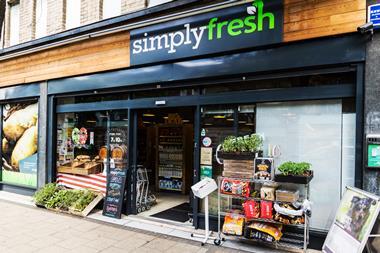After a period in the doldrums, rail retail is moving once more. Rod Addy reports
Four years ago, independent retailer Costcutter was churning out stores on railway concourses at the speed of an express train in partnership with rail network operator Connex.
All seemed to be going well, but then the project hit the buffers and everything seemed to grind to a halt.
Fast forward to January this year when a venture between Nisa-Today's and Merseyrail was announced to create a convenience store concept called M to Go. It's been the first high-profile initiative of its kind involving the development of a standard c-store chain on railway sites since the Costcutter scheme.
So are railway concessions now proving easier to get on track? And will there be more opportunities as EQT, the new owner of Select Service Partners UK Rail, Compass's rail network arm, takes time out to mull over its future strategy,?
SSP's dominance of concourse retail is one of the main factors that has historically hampered potential new entrants to the market. While there are roughly 2,500 stations in the UK, it accounts for more than 50% of the retail space at the bigger stations.
The other obstacle has been cost. Rents on such prime units don't come cheap and that's before you consider the complexity of a joint venture with the likes of SSP or a network operator. Put simply, retailers too often found that they were investing a lot of time and money in a proposition that didn't benefit them nearly as much as their partner.
However, as railway operators wake up to the benefits of a strong retail offer, they are beginning to woo operators with a more realistic proposition. Take Nisa-Today's tie-up with Merseyrail. It differs from the Costcutter partnership in that it is a straightforward supply agreement. Nisa-Today's is having no input in-store design.
In addition, the idea came from Merseyrail, which is drawing on the experience it has with similar retail schemes in Holland, so success or failure rests mainly with the network. Nisa-Today's group sales director Andrew Mouse says he's confident of the benefits, "notably an extension of the diversity within our membership and sharing of best practice in a new retail arena".
It helps that the organisation is already supplying a number of retailers with similar offerings close to railway stations, he says. The first M to Go Store is due to open in June in Moorfields, Liverpool, with the second and third scheduled to follow in September and October. Up to seven more are planned for 2007.
SSP certainly believes there's money to be made in partnership with the right retailers. It runs Thresher Group and Marks & Spencer Simply Food franchises on station concourses and owns the Whistlestop chain. Tony Keating, MD of SSP UK Rail, SSP's rail network arm, says it aims to add two more Simply Food shops within four months, although plans are up in the air with SSP's sale nearing approval.
Obviously, most opportunities for retailers exist at the bigger stations. "Liverpool Street, for example, has 123 million people passing through it every year," says Keating. "It's very difficult to make a living on a station with annual traffic lower than 500,000 people."
Many people visit stations with larger outlets purely to shop rather than catch trains, he says, but the pay-off is that these sites are scarce and competition for them is extremely fierce.
That said, Network Rail, which oversees the rail infrastructure, is discussing the redevelopment of several UK stations. Recent redevelopments, such as Manchester Piccadilly, have dramatically increased the opportunities. "There were seven or eight units at Manchester Piccadilly. Now there are almost treble that," says Keating.
In London the redevelopment of St Pancras is already under way and work is expected to begin on a Kings Cross make-over within two years. Keating says Network Rail is also considering giving Victoria and Waterloo similar treatment.
But retailers must not be so blinded by the opportunities that they fail to see the hurdles. Costcutter's agreement with Connex flopped because Connex lost its South Central rail franchise to rival operator Govia. But Costcutter had also lost its appetite for a large scale roll out of railway station stores. Sales director David Thompson, who was responsible for store development, says: "The majority of stations are very old. Trying to find a unit with the size and layout needed for a c-store is tricky and any structural work is very expensive."
Despite the willingness of network operators to form partnerships with retailers, rents remain another significant issue. Landlords can set steep charges on the best sites, which are like gold dust. A few rents are fixed, but most are proportional to turnover, with the retailers risking more than the landlords in these instances.
"If there is any downturn in business, as was the case for GNER after the bombings last year in London, landlords are protected," says Keating. "But the retailers aren't because they must guarantee high minimum rents."
With minimum trading hours written into their contracts, retailers can be driven into the ground if the climate does turn sour. It's not even obvious who retailers should initially approach to rent a site, since landlords may be independent developers rather than the rail networks. In addition, says Thompson, contracts with the networks commonly last five to 10 years, giving retailers scant time to recoup costs and make returns on their investment. That's partly because the networks are constrained by the limited franchises agreed with the Department of Transport that they have to work within and need to justify the way they run things to the government.
Thompson argues that the government should allow network operators more time to make a difference.
Connex, too, shouldered sizeable costs by electing to manage stores themselves. "It had to buy in expertise to have controls for aspects such as payroll and finances," says Thompson. "Consequently it had to build up a critical mass of outlets to make these controls viable."
The partners need to work out who bears store fitting expenses. Store development also demands the involvement of a number of different organisations depending on the site's nature. Merseyrail's second-planned M to Go store, for example, is in a listed building, so permission for alterations had to be sought from the council. A site at an underground station would require consultation with fire services.
There are other issues to consider when setting up shop, particularly in an older building. "There are often power restrictions on stations," says Keating. "So you need to determine how much power you are going to need in-store."
Even once the store is completed and fitted, there are personnel issues to consider, as staff functions change and expand. "Staff who run the stores may be selling tickets as well so you have got to break down barriers," says Thompson. "People who've been selling groceries for years don't adapt readily to selling tickets and vice versa."
Thompson doesn't rule out creating more station outlets for Costcutter, but there's no doubt the retailer is licking its wounds for the moment. Even so, if a retailer understands all the pros and cons from the outset, there are many benefits.
As Thompson himself puts it: "The captive audience and regular high footfall constitute a great opportunity."
Four years ago, independent retailer Costcutter was churning out stores on railway concourses at the speed of an express train in partnership with rail network operator Connex.
All seemed to be going well, but then the project hit the buffers and everything seemed to grind to a halt.
Fast forward to January this year when a venture between Nisa-Today's and Merseyrail was announced to create a convenience store concept called M to Go. It's been the first high-profile initiative of its kind involving the development of a standard c-store chain on railway sites since the Costcutter scheme.
So are railway concessions now proving easier to get on track? And will there be more opportunities as EQT, the new owner of Select Service Partners UK Rail, Compass's rail network arm, takes time out to mull over its future strategy,?
SSP's dominance of concourse retail is one of the main factors that has historically hampered potential new entrants to the market. While there are roughly 2,500 stations in the UK, it accounts for more than 50% of the retail space at the bigger stations.
The other obstacle has been cost. Rents on such prime units don't come cheap and that's before you consider the complexity of a joint venture with the likes of SSP or a network operator. Put simply, retailers too often found that they were investing a lot of time and money in a proposition that didn't benefit them nearly as much as their partner.
However, as railway operators wake up to the benefits of a strong retail offer, they are beginning to woo operators with a more realistic proposition. Take Nisa-Today's tie-up with Merseyrail. It differs from the Costcutter partnership in that it is a straightforward supply agreement. Nisa-Today's is having no input in-store design.
In addition, the idea came from Merseyrail, which is drawing on the experience it has with similar retail schemes in Holland, so success or failure rests mainly with the network. Nisa-Today's group sales director Andrew Mouse says he's confident of the benefits, "notably an extension of the diversity within our membership and sharing of best practice in a new retail arena".
It helps that the organisation is already supplying a number of retailers with similar offerings close to railway stations, he says. The first M to Go Store is due to open in June in Moorfields, Liverpool, with the second and third scheduled to follow in September and October. Up to seven more are planned for 2007.
SSP certainly believes there's money to be made in partnership with the right retailers. It runs Thresher Group and Marks & Spencer Simply Food franchises on station concourses and owns the Whistlestop chain. Tony Keating, MD of SSP UK Rail, SSP's rail network arm, says it aims to add two more Simply Food shops within four months, although plans are up in the air with SSP's sale nearing approval.
Obviously, most opportunities for retailers exist at the bigger stations. "Liverpool Street, for example, has 123 million people passing through it every year," says Keating. "It's very difficult to make a living on a station with annual traffic lower than 500,000 people."
Many people visit stations with larger outlets purely to shop rather than catch trains, he says, but the pay-off is that these sites are scarce and competition for them is extremely fierce.
That said, Network Rail, which oversees the rail infrastructure, is discussing the redevelopment of several UK stations. Recent redevelopments, such as Manchester Piccadilly, have dramatically increased the opportunities. "There were seven or eight units at Manchester Piccadilly. Now there are almost treble that," says Keating.
In London the redevelopment of St Pancras is already under way and work is expected to begin on a Kings Cross make-over within two years. Keating says Network Rail is also considering giving Victoria and Waterloo similar treatment.
But retailers must not be so blinded by the opportunities that they fail to see the hurdles. Costcutter's agreement with Connex flopped because Connex lost its South Central rail franchise to rival operator Govia. But Costcutter had also lost its appetite for a large scale roll out of railway station stores. Sales director David Thompson, who was responsible for store development, says: "The majority of stations are very old. Trying to find a unit with the size and layout needed for a c-store is tricky and any structural work is very expensive."
Despite the willingness of network operators to form partnerships with retailers, rents remain another significant issue. Landlords can set steep charges on the best sites, which are like gold dust. A few rents are fixed, but most are proportional to turnover, with the retailers risking more than the landlords in these instances.
"If there is any downturn in business, as was the case for GNER after the bombings last year in London, landlords are protected," says Keating. "But the retailers aren't because they must guarantee high minimum rents."
With minimum trading hours written into their contracts, retailers can be driven into the ground if the climate does turn sour. It's not even obvious who retailers should initially approach to rent a site, since landlords may be independent developers rather than the rail networks. In addition, says Thompson, contracts with the networks commonly last five to 10 years, giving retailers scant time to recoup costs and make returns on their investment. That's partly because the networks are constrained by the limited franchises agreed with the Department of Transport that they have to work within and need to justify the way they run things to the government.
Thompson argues that the government should allow network operators more time to make a difference.
Connex, too, shouldered sizeable costs by electing to manage stores themselves. "It had to buy in expertise to have controls for aspects such as payroll and finances," says Thompson. "Consequently it had to build up a critical mass of outlets to make these controls viable."
The partners need to work out who bears store fitting expenses. Store development also demands the involvement of a number of different organisations depending on the site's nature. Merseyrail's second-planned M to Go store, for example, is in a listed building, so permission for alterations had to be sought from the council. A site at an underground station would require consultation with fire services.
There are other issues to consider when setting up shop, particularly in an older building. "There are often power restrictions on stations," says Keating. "So you need to determine how much power you are going to need in-store."
Even once the store is completed and fitted, there are personnel issues to consider, as staff functions change and expand. "Staff who run the stores may be selling tickets as well so you have got to break down barriers," says Thompson. "People who've been selling groceries for years don't adapt readily to selling tickets and vice versa."
Thompson doesn't rule out creating more station outlets for Costcutter, but there's no doubt the retailer is licking its wounds for the moment. Even so, if a retailer understands all the pros and cons from the outset, there are many benefits.
As Thompson himself puts it: "The captive audience and regular high footfall constitute a great opportunity."


















No comments yet